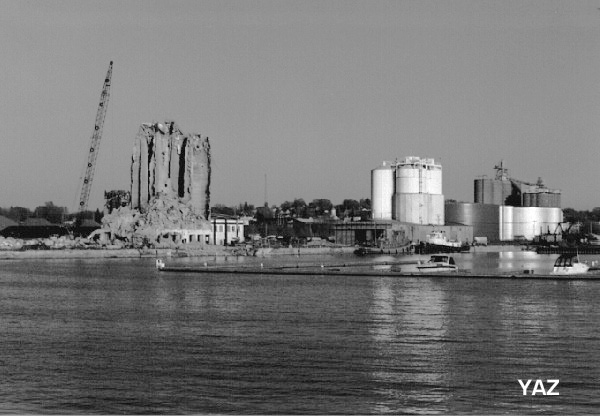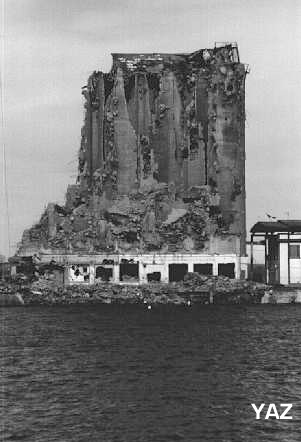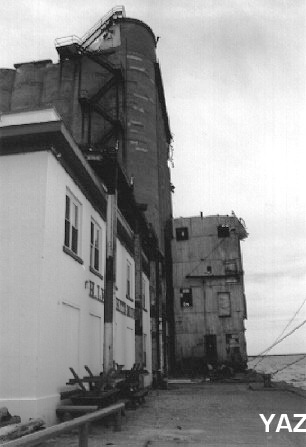
All that's left of the grain elevator in the spring of 1999.

At the northern end of West First Street in Oswego stood a monolithic structure. This building, a grain elevator, had dominated the west side pier since 1925. It was once an important key to the future economic success of Oswego and the New York State Barge Canal. But this building recently fell into disuse, and was demolished in 1999.
Although there were no facilities for the transfer of grain in Oswego in the years before to 1925, there had been grain elevators in Oswego previously. Oswego newspapers of the 1850s tell of new elevators being constructed. The Ames grain elevator and warehouse of 1851 was at the foot of East Cayuga Street, was five stories high, and could store 100,000 bushels of grain . Clark Abbey constructed an elevator "upon the 'burnt district' north of the Toll bridge" in 1853 which was six stories tall and stored 250,000 bushels of grain.

In 1920, the State Legislature of New York passed an Act authorizing the construction of grain elevators at Oswego and Gowanus Bay, Brooklyn. The elevator at Gowanus Bay opened in 1922, and held a capacity of 2,000,000 bushels.
The Grain Elevator at the end of the west pier in Oswego opened in 1925 and had a capacity of 1,000,000 bushels. It was constructed of concrete and local beach stone. Modern buildings would not use the same construction, because it is not cost effective, but it has made the Elevator a substantial structure. Demolition began in October 1998, and is expected to continue until May 1999.
The Grain Elevator was 1000 feet long, 150 feet wide, and 189 feet to the top of the cupola, or penthouse, as it is called by the workers. On the east side of the elevator are two movable marine towers. The towers were made of structural steel framework and covered with galvanized corrugated metal, and the floor and roof are made of concrete. Each tower weighed one million tons, and moved on 40 cast iron car wheels. On the west side of the elevator was the car shed, and rail tracks there connect with the Delaware, Lackawanna & Western Railroad, allowing for the transfer of grain during winter months when the canal would be closed. Above the car shed was a dust house for collecting and packing dust, as a means of reducing the risk of fire and explosion.
Directly south of the Grain Elevator was the administration building, which is still standing and is now the H. Lee White Marine Museum, and a brick freighthouse, which was demolished April 1999.
Inside the Grain Elevator were 27 circular storage bins, arranged in nine rows of three bins each. Each bin was 20 feet inside diameter, and 94 feet high. There were also "16 interstitial bins and 20 quarter bins".
On each marine tower was a 90-ton leg. Each leg had a canvas conveyor belt; the legs would take grain from lake vessels at a rate of 2,200 bushel an hour, 100 scoops a minute. The legs carried the grain into lofters, which were basically vertical legs inside the marine towers, and carry the grain to the top of the elevator and drop it into the bins. Before the grain was dropped into the bins, it would be weighed in 500-pound scales in the marine tower.
The construction was done under four
separate contracts; James Stewart & Company, Inc., were responsible
for the "57 foundation piers, the main elevator, the marine towers, track
work and administration building." The Dodge Manufacturing Corporation
were responsible for much of the machinery, and two other contracts involved
machinery.
 |
 |
Inside the grain elevator were 3 lofters, which ran from the bottom of the building to the top. Grain would be taken in buckets attached to conveyor belts to the top, where it was measured in a 2,000-bushel scale. This is the same process as in the marine towers, but on a much bigger scale. The grain is then sent to the shipping bins, three large silos on the west side of the elevator. These were for loading out purposes only, and would empty out in to the car shed. Grain loaded out at a rate of 20,000 bushels per hour. This is where the Genesee trucks were loaded when Rick Woods and George Nesbitt worked at the elevator, but in earlier years, barges or rail cars would be loaded here.
During normal working hours, the shifts were from 8 am to 5 pm. During the 1980Õs, the work consisted of loading six trucks of barley a day for Genesee Beer. When the grain ships came in, the shifts were from 8 am to midnight. Work at this time consisted solely of loading grain out of the ships and into the elevator.
In earlier years, the State of New York owned the Grain Elevator and there were no leases. This was from its time of construction until the Port of Oswego Authority took over ownership. For a fee, the State offered temporary storage of grain at its facility. Cargo, the world's largest grain company, stored wheat, flax and barley at the Grain Elevator. This was also before the opening of the St. Lawrence Seaway. Grain was loaded onto barges, which sailed down the Barge Canal to Albany, where the grain was loaded onto ocean-going vessels, which went to Europe and other places.
When the St. Lawrence Seaway opened,
it eliminated the need for most companies to use the Grain Elevator. Ocean-going
vessels that could then pass through the Seaway were capable of handling
1 million bushels of grain, the capacity of the Grain Elevator, therefore
allowing ships to bypass the elevator. Genesee Beer was one of the earlier
companies that used the Grain Elevator, and continued to do so after the
opening of the Seaway. Genesee stored barley at the Grain Elevator, and
then sent that barley by truck to Sodus, where there was a malt-house.
The continued use of the elevator was still profitable for both Genesee
and the Port Authority. After processing the barley into malt, the malt
was then shipped from Sodus to Rochester, where the Genesee Brewery was
located.
In later years (c.1980s), Genesee
Beer used the elevator exclusively. Three ships a year would come in, two
ships of 250,000 bushels in the spring, and one of 500,000 bushel in the
fall. Genesee Beer did not renew their contract in 1986. Genesee decided
not to renew because the malt-house in Sodus was not capable of handling
the amount Genesee desired, and the availability of larger grain elevators
at Buffalo for reduced prices were favorable for the company to change
locations. There was surplus of corn in the 1980s, and private companies
stored grain at the Elevator after Genesee left until c.1990. The Grain
Elevator was vacant from that time until its demolition starting in October
1998.
The Hilton Hotel chain looked into converting the Grain Elevator into a hotel, but instead chose to renovate an Akron, Ohio, elevator, which had bins with larger diameters than the bins at Oswego. The demolition of the Oswego grain elevator had become feasible in 1998 due to the availability of funds.
-excerpted from Internship Research Paper, Robert Yasinsac.
May 1999.
Please visit the website of the
H. Lee White Marine Museum, whish is housed in
the office of the old Grain Elevator.
Other Grain Elevator Links:
The Country Grain
Elevator Historical Society - Dedicated to the preservation of various
Grain Elevators.
Grain
Elevator Bibliography
Crowne
Plaza Akron - A grain elevator converted into a hotel.
Red Hook Grain Terminal
- Sister terminal to the Oswego Elevator.
Text and photographs copyright
© 1999 by Robert Yasinsac.
No reproduction or copying of these images
in any form is permitted without he consent of Robert Yasinsac.